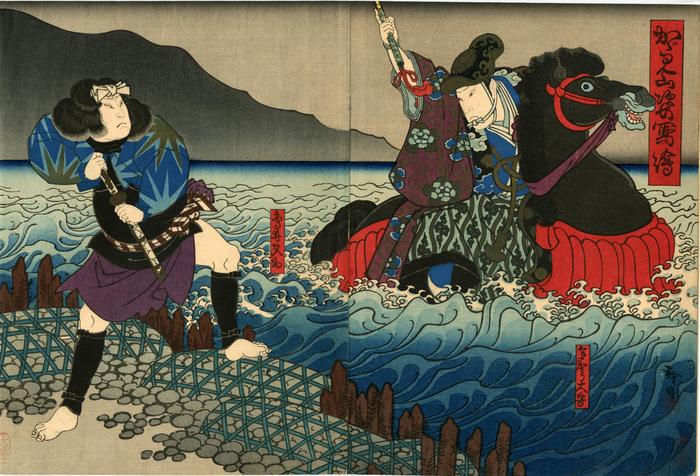Utagawa Hirosada (歌川広貞: 1810-1864) (artist 1810 – 1864)
Kataoka Gadō II as Taga no Taishu (多賀大守) on the right and Onoe Tamizō II as Torii Matasuke (鳥井又助) in the play Kagamiyama Sugata no Utsushie (加賀見山姿写絵)
10/1852
37 cm x 25.1 cm (Overall dimensions) woodblock print
Signed: Hirosada (広貞)
Publisher: Daijin (Marks 029 - seal 20-039)
printed in red - partially trimmed along left
edge of lower left-hand panel and
full seal, barely visible, in the lower right
of the right-hand print
Waseda University - the right panel
Waseda University - left panel
Lyon Collection - a related triptych by Toyokuni I
Lyon Collection - a related triptych by Sadanobu
Hankyu Culture Foundation - right panel
Hankyu Culture Foundation - left panel
Museum of Fine Arts, Boston - an 1818 Ashiyuki diptych of the encounter of these two protagonists The people at Osaka Prints give a decent summary of the background of this composition. Note that the items in bold type are our choice because of their connection to other subjects in the Lyon Collection.
The play Kagamiyama sugata no utsushi-e (A true picture likeness at Mirror Mountain: 鏡山姿写絵) premiered with the performance depicted in Hirosada's diptych. It is related to a group of Kagamiyama mono (Kaga Mountain Plays: 加賀見山物) both from the puppet and kabuki theaters that were adapted from the ningyô jôruri (puppet play: 人形淨瑠璃) Kagamiyama kokyô no nishiki-e (A brocade picture of the birthplace at Mirror Mountain: 鏡山舊錦絵), premiering in Edo, 1782. These plays dramatized eighteenth-century rivalries within the Maeda clan in Kaga....****
The main plot line (not depicted here) was based on a real-life incident from 1724 when at the Edo palace of Lord Matsudaira of Suo, the maidservant Osatsu avenged the death of her mistress, Omichi, who had been driven to suicide after being struck by a sandal — considered a terrible insult — by a woman named Sawano. In typical fashion, theatrical adaptations changed the names of the protagonists. After the lady-in-waiting Onoe uncovers a plot to seize power from the shogun by an court woman named Iwafuji, the latter insults Onoe by striking her with a sandal. Onoe commits suicide, but only after revealing the conspiracy to her maid, Ohatsu. The dutiful maid foils the intrigue and kills Iwafuji with a sword, then symbolically beats the corpse with Onoe’s blood-stained sandal.
In the present play Kagamiyama sugata no utsushi-e, the Kaga clan name has been changed to Taga, hence the role Taga no Taishu. The role of Torii Matasuke originally appeared in the Kyoto-based play Kagamiyama sato no kikigaki (1780), written by Nagawa Kamesuke (died 1790). The scene shown here, once part of the original play, is no longer performed. It included an armed confrontation between Torii Matasuke and a lord named Taga. The two meet at the river's edge, Taga riding a black war horse in the fast-flowing current and Matasuke poised for action. The mie ("display" or dramatic pose: 見得) of the two actors must have thrilled kabuki audiences of the period, with Matasuke gripping his wakizashi (short sword: 脇差) and Lord Taga ready to match Matasuke's ferocity. Later in the play Matasuke sacrifices himself and then, at the climax, returns as a vengeful spirit to defeat his enemies.
Chūban diptych with metallic printing and burnishing, album backed.
This diptych commemorates a performance at the Naka Theater in 10/1852.
****
Illustrated in Ikeda Bunko, Kamigata yakusha-e shūsei (Collected Kamigata Actor Prints), vol. 4, 2003, #488.
****
Osaka Prints says that this diptych was produced by Daijin (大甚 - Marks U029).
****
Torii Matasuke is tricked into killing his own master. Here he is waiting along the bank of a river for the man he thinks is his enemy to arrive. He stands there with his bare right foot planted squarely on the ground, while his left foot is placed on a gabion or jakago (蛇籠), a bamboo basket filled with stone to prevent erosion. The same bamboo utility item appears in three of the prints showing Torii Matasuke in the Lyon Collection. The earliest example is in a Yoshikuni print from 1821 and the other two are by Kuniyoshi and Hirosada, both dated to 1852.
Another commonality shared by two of these prints was the 'starfish' pattern of the shibori (絞り) or tie-dyed fabric Matsusuke is wearing. In the Yoshikuni print it is the lower part of his outfit, while in the Hirosada it is the top.
Kyōto-Osaka prints (kamigata-e - 上方絵) (genre)
actor prints (yakusha-e - 役者絵) (genre)
Onoe Tamizō II (二代目尾上多見蔵: 11/1820-1848; 1850-November, 1885) (actor)
Kataoka Gadō II (二代目片岡我童: from 1837 to 12/1856) (actor)
Daijin (大甚) (publisher)
Keisei Kagamiyama (けいせい双鏡山) (kabuki)
